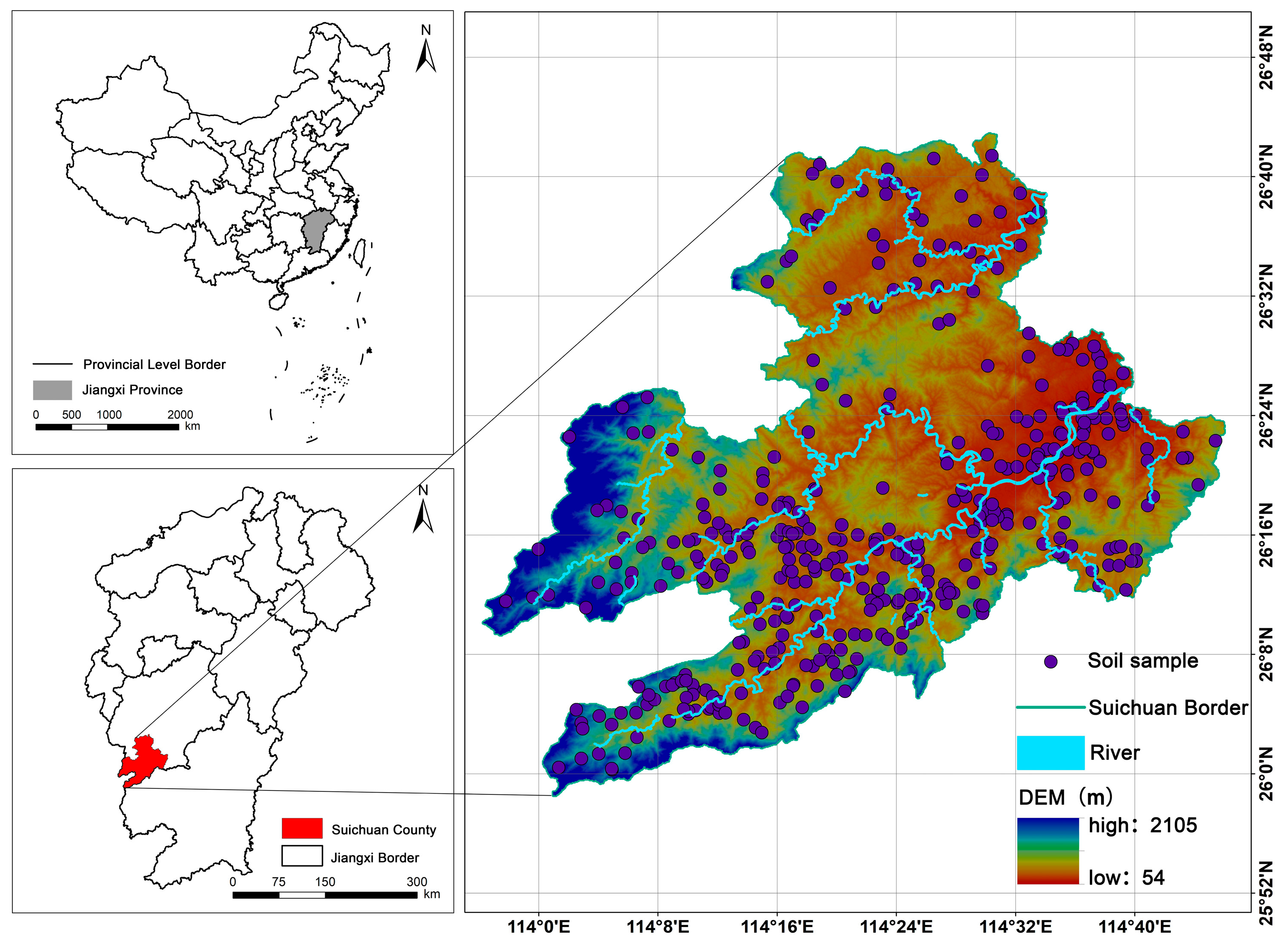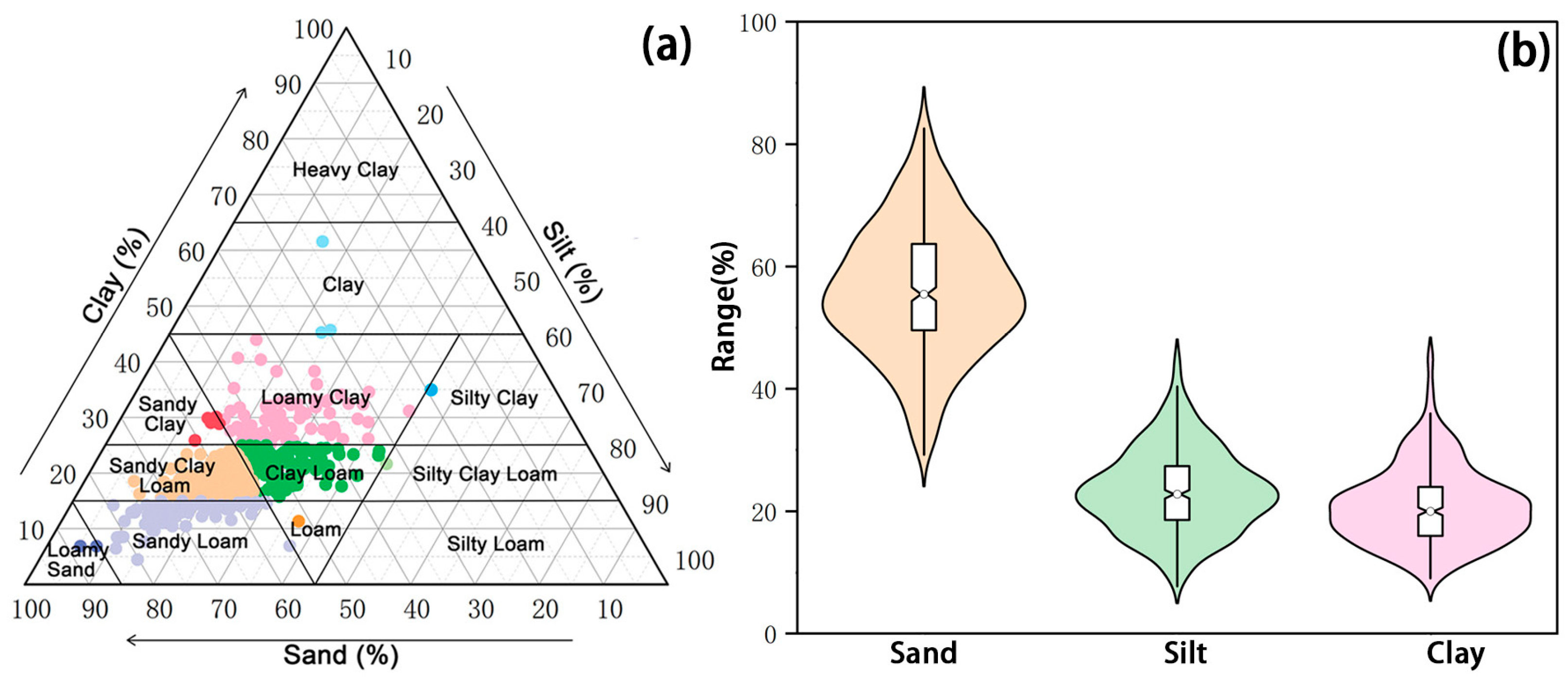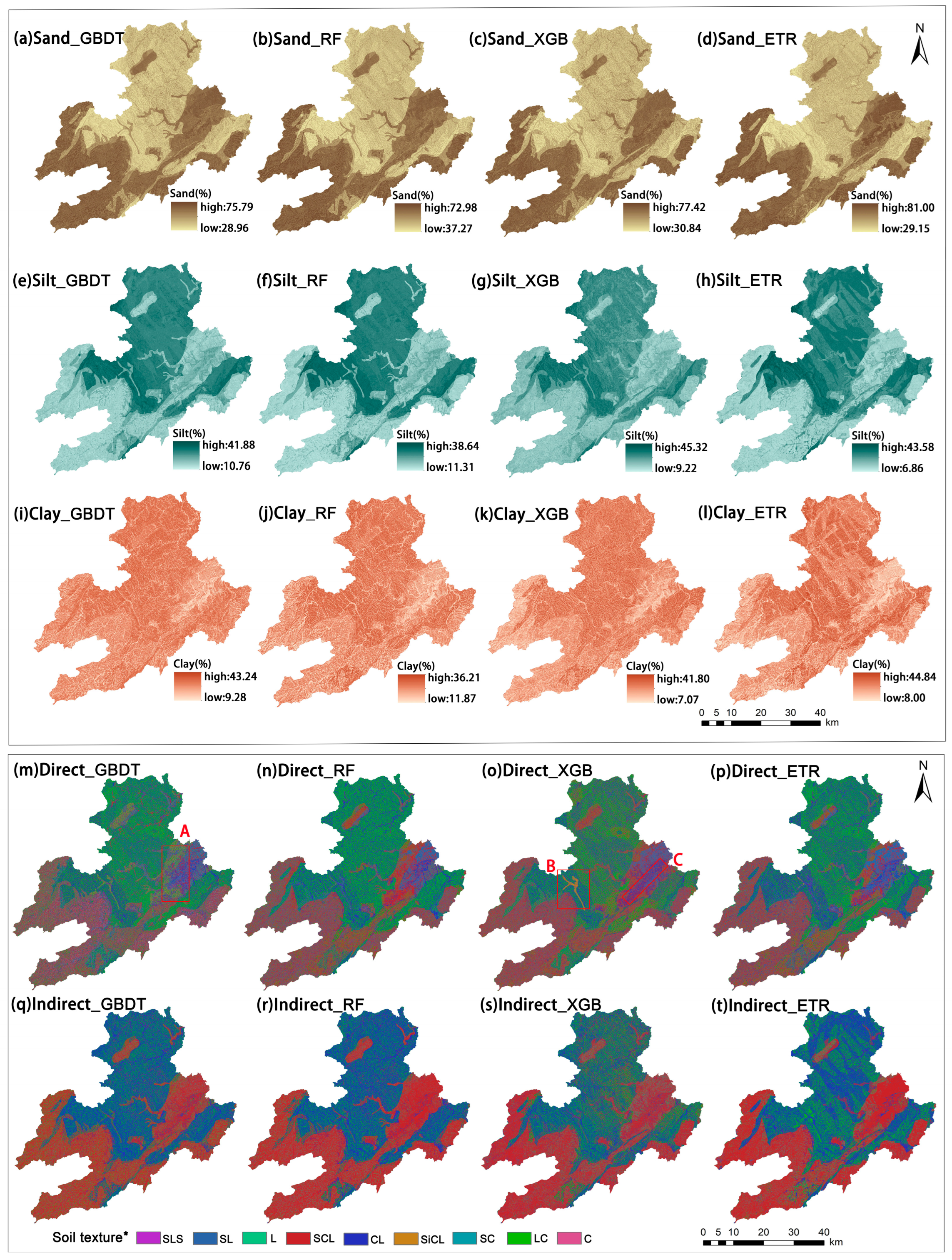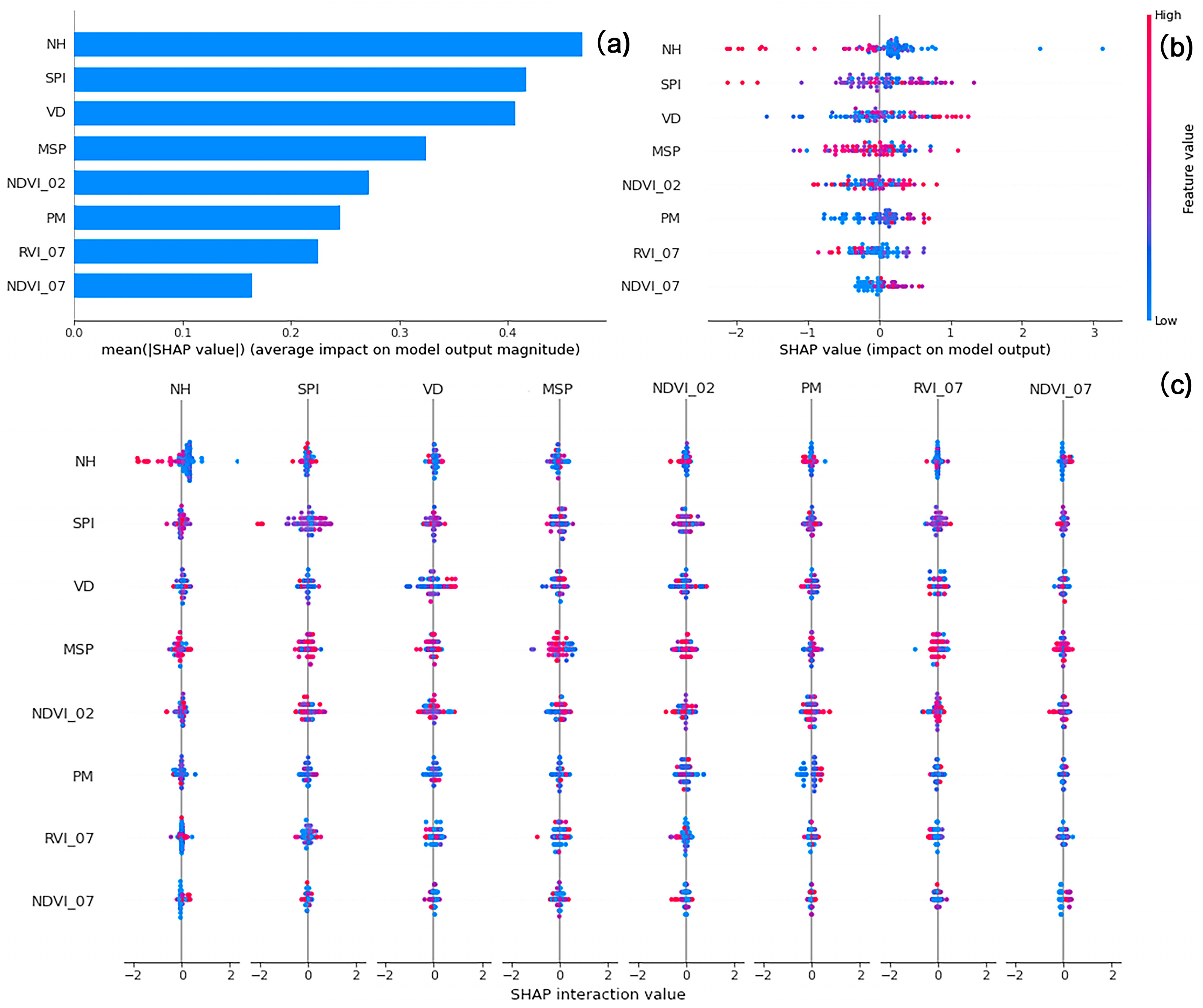Machine Learning-Based Comparative Analysis on Direct and Indirect Mapping of Soil Texture Types Through Soil Particle Size Fractions Using Multi-Source Remote Sensing
Abstract
1. Introduction
2. Materials and Methods
2.1. Study Area
2.2. Soil Sampling and Laboratory Analysis
2.3. Environmental Covariates
2.3.1. Relief
2.3.2. Remote Sensing Images
2.4. Predictive Modelling Approaches
2.4.1. Direct Prediction Approach
2.4.2. Indirect Prediction Approach
2.5. Evaluation of Feature Importance
2.6. Validation of Soil Texture Classification
2.6.1. Evaluation Indicators for Soil Texture Classification
2.6.2. Evaluation Indicators for Soil PSF Prediction
3. Results
3.1. Descriptive Statistics of the Soil Samples
3.2. Direct Prediction of the Soil Textures
3.3. Indirect Prediction of the Soil Textures
3.4. Comparison of the Direct and Indirect Soil Texture Predictions
3.5. Interpretable Prediction of Soil Texture
4. Discussion
4.1. Effectiveness of Multi-Source Remote Sensing in Soil Texture Prediction
4.2. Comparison of Different Approaches Used in Soil Texture Mapping
4.3. Interpretability of Soil Texture Spatial Distribution
4.4. Limitations and Deficiencies
5. Conclusions
Supplementary Materials
Author Contributions
Funding
Institutional Review Board Statement
Data Availability Statement
Conflicts of Interest
References
- Koseva, I.S.; Watmough, S.A.; Aherne, J. Estimating base cation weathering rates in Canadian forest soils using a simple texture-based model. Biogeochemistry 2010, 101, 183–196. [Google Scholar] [CrossRef]
- Vaughan, E.; Matos, M.; Ríos, S.; Santiago, C.; Marín-Spiotta, E. Clay and climate are poor predictors of regional-scale soil carbon storage in the US Caribbean. Geoderma 2019, 354, 113841. [Google Scholar] [CrossRef]
- Ding, X.; Zhao, Z.; Yang, Q.; Chen, L.; Tian, Q.; Li, X.; Meng, F. Model prediction of depth-specific soil texture distributions with artificial neural network: A case study in Yunfu, a typical area of Udults Zone, South China. Comput. Electron. Agric. 2020, 169, 105217. [Google Scholar] [CrossRef]
- Ließ, M.; Glaser, B.; Huwe, B. Uncertainty in the spatial prediction of soil texture: Comparison of regression tree and Random Forest models. Geoderma 2012, 170, 70–79. [Google Scholar] [CrossRef]
- Mulder, V.L.; Lacoste, M.; Richer-de-Forges, A.C.; Arrouays, D. GlobalSoilMap France: High-resolution spatial modelling the soils of France up to two meter depth. Sci. Total Environ. 2016, 573, 1352–1369. [Google Scholar] [CrossRef] [PubMed]
- Singha, C.; Swain, K.C. Land suitability evaluation criteria for agricultural crop selection: A review. Agric. Rev. 2016, 37, 125–132. [Google Scholar] [CrossRef]
- Song, W.; Zhang, H.; Zhao, R.; Wu, K.; Li, X.; Niu, B.; Li, J. Study on cultivated land quality evaluation from the perspective of farmland ecosystems. Ecol. Indic. 2022, 139, 108959. [Google Scholar] [CrossRef]
- Zhao, Z.; Chow, T.L.; Rees, H.W.; Yang, Q.; Xing, Z.; Meng, F. Predict soil texture distributions using an artificial neural network model. Comput. Electron. Agric. 2009, 65, 36–48. [Google Scholar] [CrossRef]
- McBratney, A.B.; Santos, M.M.; Minasny, B. On digital soil mapping. Geoderma 2003, 117, 3–52. [Google Scholar] [CrossRef]
- Chen, S.; Arrouays, D.; Mulder, V.L.; Poggio, L.; Minasny, B.; Roudier, P.; Libohova, Z.; Lagacherie, P.; Shi, Z.; Hannam, J. Digital mapping of GlobalSoilMap soil properties at a broad scale: A review. Geoderma 2022, 409, 115567. [Google Scholar] [CrossRef]
- Sanchez, P.A.; Ahamed, S.; Carré, F.; Hartemink, A.E.; Hempel, J.; Huising, J.; Lagacherie, P.; McBratney, A.B.; McKenzie, N.J.; Mendonça-Santos, M.D.L. Digital soil map of the world. Science 2009, 325, 680–681. [Google Scholar] [CrossRef] [PubMed]
- Adhikari, K.; Kheir, R.B.; Greve, M.B.; Bøcher, P.K.; Malone, B.P.; Minasny, B.; McBratney, A.B.; Greve, M.H. High-resolution 3-D mapping of soil texture in Denmark. Soil Sci. Soc. Am. J. 2013, 77, 860–876. [Google Scholar] [CrossRef]
- Casa, R.; Castaldi, F.; Pascucci, S.; Palombo, A.; Pignatti, S. A comparison of sensor resolution and calibration strategies for soil texture estimation from hyperspectral remote sensing. Geoderma 2013, 197, 17–26. [Google Scholar] [CrossRef]
- Gasmi, A.; Gomez, C.; Lagacherie, P.; Zouari, H.; Laamrani, A.; Chehbouni, A. Mean spectral reflectance from bare soil pixels along a Landsat-TM time series to increase both the prediction accuracy of soil clay content and mapping coverage. Geoderma 2021, 388, 114864. [Google Scholar] [CrossRef]
- de Carvalho Junior, W.; Lagacherie, P.; Da Silva Chagas, C.; Calderano Filho, B.; Bhering, S.B. A regional-scale assessment of digital mapping of soil attributes in a tropical hillslope environment. Geoderma 2014, 232, 479–486. [Google Scholar] [CrossRef]
- Ceddia, M.B.; Gomes, A.S.; Vasques, G.M.; Pinheiro, É.F. Soil carbon stock and particle size fractions in the central Amazon predicted from remotely sensed relief, multispectral and radar data. Remote Sens. 2017, 9, 124. [Google Scholar] [CrossRef]
- Loiseau, T.; Chen, S.; Mulder, V.L.; Dobarco, M.R.; Richer-de-Forges, A.C.; Lehmann, S.; Bourennane, H.; Saby, N.P.; Martin, M.P.; Vaudour, E. Satellite data integration for soil clay content modelling at a national scale. Int. J. Appl. Earth Obs. 2019, 82, 101905. [Google Scholar] [CrossRef]
- Wang, N.; Chen, S.; Huang, J.; Frappart, F.; Taghizadeh, R.; Zhang, X.; Wigneron, J.; Xue, J.; Xiao, Y.; Peng, J. Global soil salinity estimation at 10 m using multi-source remote sensing. J. Remote Sens. 2024, 4, 130. [Google Scholar] [CrossRef]
- Zhang, X.; Xue, J.; Chen, S.; Zhuo, Z.; Wang, Z.; Chen, X.; Xiao, Y.; Shi, Z. Improving model performance in mapping cropland soil organic matter using time-series remote sensing data. J. Integr. Agric. 2024, 23, 2820–2841. [Google Scholar] [CrossRef]
- Kumar, A.; Kishore, B.; Saikia, P.; Deka, J.; Bharali, S.; Singha, L.B.; Tripathi, O.P.; Khan, M.L. Tree diversity assessment and above ground forests biomass estimation using SAR remote sensing: A case study of higher altitude vegetation of North-East Himalayas, India. Phys. Chem. Earth Parts A/B/C 2019, 111, 53–64. [Google Scholar] [CrossRef]
- Wang, J.; Xiao, X.; Bajgain, R.; Starks, P.; Steiner, J.; Doughty, R.B.; Chang, Q. Estimating leaf area index and aboveground biomass of grazing pastures using Sentinel-1, Sentinel-2 and Landsat images. Isprs. J. Photogramm. 2019, 154, 189–201. [Google Scholar] [CrossRef]
- Meroni, M.; D’Andrimont, R.; Vrieling, A.; Fasbender, D.; Lemoine, G.; Rembold, F.; Seguini, L.; Verhegghen, A. Comparing land surface phenology of major European crops as derived from SAR and multispectral data of Sentinel-1 and-2. Remote Sens. Environ. 2021, 253, 112232. [Google Scholar] [CrossRef] [PubMed]
- Laborczi, A.; Szatmári, G.; Takács, K.; Pásztor, L. Mapping of topsoil texture in Hungary using classification trees. J. Maps 2016, 12, 999–1009. [Google Scholar] [CrossRef]
- Maynard, J.J.; Levi, M.R. Hyper-temporal remote sensing for digital soil mapping: Characterizing soil-vegetation response to climatic variability. Geoderma 2017, 285, 94–109. [Google Scholar] [CrossRef]
- Gomez, C.; Dharumarajan, S.; Féret, J.; Lagacherie, P.; Ruiz, L.; Sekhar, M. Use of sentinel-2 time-series images for classification and uncertainty analysis of inherent biophysical property: Case of soil texture mapping. Remote Sens. 2019, 11, 565. [Google Scholar] [CrossRef]
- Pahlavan-Rad, M.R.; Akbarimoghaddam, A. Spatial variability of soil texture fractions and pH in a flood plain (case study from eastern Iran). Catena 2018, 160, 275–281. [Google Scholar] [CrossRef]
- Amirian-Chakan, A.; Minasny, B.; Taghizadeh-Mehrjardi, R.; Akbarifazli, R.; Darvishpasand, Z.; Khordehbin, S. Some practical aspects of predicting texture data in digital soil mapping. Soil Tillage Res. 2019, 194, 104289. [Google Scholar] [CrossRef]
- Liu, F.; Zhang, G.; Song, X.; Li, D.; Zhao, Y.; Yang, J.; Wu, H.; Yang, F. High-resolution and three-dimensional mapping of soil texture of China. Geoderma 2020, 361, 114061. [Google Scholar] [CrossRef]
- Odeh, I.O.; Todd, A.J.; Triantafilis, J. Spatial prediction of soil particle-size fractions as compositional data. Soil Sci. 2003, 168, 501–515. [Google Scholar] [CrossRef]
- Greenacre, M. Compositional data analysis. Annu. Rev. Stat. Appl. 2021, 8, 271–299. [Google Scholar] [CrossRef]
- Shi, W.; Zhang, M. Progress on spatial prediction methods for soil particle-size fractions. J. Geogr. Sci. 2023, 33, 1553–1566. [Google Scholar] [CrossRef]
- Aitchison, J. On criteria for measures of compositional difference. Math. Geol. 1992, 24, 365–379. [Google Scholar] [CrossRef]
- Zhang, S.; Wang, S.; Liu, N.; Li, N.; Huang, Y.; Ye, H. Comparison of spatial prediction method for soil texture. Trans. Chin. Soc. Agric. Eng. 2011, 27, 332–339. [Google Scholar]
- Li, J.; Wan, H.; Shang, S. Comparison of interpolation methods for mapping layered soil particle-size fractions and texture in an arid oasis. Catena 2020, 190, 104514. [Google Scholar] [CrossRef]
- Mirzaei, F.; Amirian-Chakan, A.; Taghizadeh-Mehrjardi, R.; Matinfar, H.R.; Kerry, R. Soil textural class modeling using digital soil mapping approaches: Effect of resampling strategies on imbalanced dataset predictions. Geoderma Reg. 2024, 38, e00821. [Google Scholar] [CrossRef]
- Nenkam, A.M.; Wadoux, A.M.; Minasny, B.; Silatsa, F.B.; Yemefack, M.; Ugbaje, S.U.; Akpa, S.; Van Zijl, G.; Bouasria, A.; Bouslihim, Y. Applications and challenges of digital soil mapping in Africa. Geoderma 2024, 449, 117007. [Google Scholar] [CrossRef]
- Qu, L.; Lu, H.; Tian, Z.; Schoorl, J.M.; Huang, B.; Liang, Y.; Qiu, D.; Liang, Y. Spatial prediction of soil sand content at various sampling density based on geostatistical and machine learning algorithms in plain areas. Catena 2024, 234, 107572. [Google Scholar] [CrossRef]
- Bousbih, S.; Zribi, M.; Pelletier, C.; Gorrab, A.; Lili-Chabaane, Z.; Baghdadi, N.; Ben Aissa, N.; Mougenot, B. Soil texture estimation using radar and optical data from Sentinel-1 and Sentinel-2. Remote Sens. 2019, 11, 1520. [Google Scholar] [CrossRef]
- Zhou, Y.; Wu, W.; Liu, H. Exploring the Influencing Factors in Identifying Soil Texture Classes Using Multitemporal Landsat-8 and Sentinel-2 Data. Remote Sens. 2022, 14, 5571. [Google Scholar] [CrossRef]
- Ning, J.; Yao, Y.; Tang, Q.; Li, Y.; Fisher, J.B.; Zhang, X.; Jia, K.; Xu, J.; Shang, K.; Yang, J. Soil moisture at 30 m from multiple satellite datasets fused by random forest. J. Hydrol. 2023, 625, 130010. [Google Scholar] [CrossRef]
- Mirzaeitalarposhti, R.; Shafizadeh-Moghadam, H.; Taghizadeh-Mehrjardi, R.; Demyan, M.S. Digital soil texture mapping and spatial transferability of machine learning models using sentinel-1, sentinel-2, and terrain-derived covariates. Remote Sens. 2022, 14, 5909. [Google Scholar] [CrossRef]
- Zhang, M.; Shi, W.; Xu, Z. Systematic comparison of five machine-learning models in classification and interpolation of soil particle size fractions using different transformed data. Hydrol. Earth Syst. Sc. 2020, 24, 2505–2526. [Google Scholar] [CrossRef]
- Zhang, X.; Xue, J.; Chen, S.; Wang, N.; Xie, T.; Xiao, Y.; Chen, X.; Shi, Z.; Huang, Y.; Zhuo, Z. Fine Resolution Mapping of Soil Organic Carbon in Croplands with Feature Selection and Machine Learning in Northeast Plain China. Remote Sens. 2023, 15, 5033. [Google Scholar] [CrossRef]
- Darst, B.F.; Malecki, K.C.; Engelman, C.D. Using recursive feature elimination in random forest to account for correlated variables in high dimensional data. BMC Genet. 2018, 19, 65. [Google Scholar] [CrossRef] [PubMed]
- Azizi, K.; Garosi, Y.; Ayoubi, S.; Tajik, S. Integration of Sentinel-1/2 and topographic attributes to predict the spatial distribution of soil texture fractions in some agricultural soils of western Iran. Soil Tillage Res. 2023, 229, 105681. [Google Scholar] [CrossRef]
- Trudel, M.; Charbonneau, F.; Leconte, R. Using RADARSAT-2 polarimetric and ENVISAT-ASAR dual-polarization data for estimating soil moisture over agricultural fields. Can. J. Remote Sens. 2012, 38, 514–527. [Google Scholar] [CrossRef]
- Veloso, A.; Mermoz, S.; Bouvet, A.; Le Toan, T.; Planells, M.; Dejoux, J.; Ceschia, E. Understanding the temporal behavior of crops using Sentinel-1 and Sentinel-2-like data for agricultural applications. Remote Sens. Environ. 2017, 199, 415–426. [Google Scholar] [CrossRef]
- Gholizadeh, A.; Žižala, D.; Saberioon, M.; Borůvka, L. Soil organic carbon and texture retrieving and mapping using proximal, airborne and Sentinel-2 spectral imaging. Remote Sens. Environ. 2018, 218, 89–103. [Google Scholar] [CrossRef]
- Gia Pham, T.; Kappas, M.; Van Huynh, C.; Hoang Khanh Nguyen, L. Application of ordinary kriging and regression kriging method for soil properties mapping in hilly region of Central Vietnam. Isprs. Int. J. Geo-Inf. 2019, 8, 147. [Google Scholar] [CrossRef]
- Zhou, Y.; Wu, W.; Wang, H.; Zhang, X.; Yang, C.; Liu, H. Identification of soil texture classes under vegetation cover based on Sentinel-2 data with SVM and SHAP techniques. IEEE J.-Stars. 2022, 15, 3758–3770. [Google Scholar] [CrossRef]
- Shirazi, F.R.A.; Shahbazi, F.; Rezaei, H.; Biswas, A. Multi-property digital soil mapping at 30-m spatial resolution down to 1 m using extreme gradient boosting tree model and environmental covariates. Remote Sens. Appl. Soc. Environ. 2024, 33, 101123. [Google Scholar] [CrossRef]
- Zhai, Y.; Thomasson, J.A.; Boggess III, J.E.; Sui, R. Soil texture classification with artificial neural networks operating on remote sensing data. Comput. Electron. Agric. 2006, 54, 53–68. [Google Scholar] [CrossRef]
- Yang, L.; Mansaray, L.R.; Huang, J.; Wang, L. Optimal segmentation scale parameter, feature subset and classification algorithm for geographic object-based crop recognition using multisource satellite imagery. Remote Sens. 2019, 11, 514. [Google Scholar] [CrossRef]
- Breiman, L. Random Forests. Mach. Learn. 2001, 45, 5–32. [Google Scholar] [CrossRef]
- Chen, T.; Guestrin, C. Xgboost: A scalable tree boosting system. In Proceedings of the 22nd ACM SIGKDD International Conference on Knowledge Discovery and Data Mining, San Francisco, CA, USA, 13–17 August 2016; pp. 785–794. [Google Scholar] [CrossRef]
- Geurts, P.; Ernst, D.; Wehenkel, L. Extremely randomized trees. Mach. Learn. 2006, 63, 3–42. [Google Scholar] [CrossRef]
- Wang, H.; Zhang, W.; Sun, F.; Zhang, W. A comparison study of machine learning based algorithms for fatigue crack growth calculation. Materials 2017, 10, 543. [Google Scholar] [CrossRef]
- Pelikan, M.; Pelikan, M. Hierarchical Bayesian Optimization Algorithm; Springer: Berlin/Heidelberg, Germany, 2005; ISBN 3540237747. [Google Scholar] [CrossRef]
- Lundberg, S.; Lee, S. A unified approach to interpreting model predictions. arXiv 2017, arXiv:1705.07874. [Google Scholar]
- Congalton, R.G.; Green, K. Assessing the Accuracy of Remotely Sensed Data: Principles and Practices; CRC Press: Boca Raton, FL, USA, 2019; ISBN 0429052723. [Google Scholar] [CrossRef]
- Burrough, P.A.; van Gaans, P.F.M.; Hootsmans, R. Continuous classification in soil survey: Spatial correlation, confusion and boundaries. Geoderma 1997, 77, 115–135. [Google Scholar] [CrossRef]
- Chai, T.; Draxler, R.R. Root mean square error (RMSE) or mean absolute error (MAE)?—Arguments against avoiding RMSE in the literature. Geosci. Model Dev. 2014, 7, 1247–1250. [Google Scholar] [CrossRef]
- Zhou, T.; Geng, Y.; Chen, J.; Pan, J.; Haase, D.; Lausch, A. High-resolution digital mapping of soil organic carbon and soil total nitrogen using DEM derivatives, Sentinel-1 and Sentinel-2 data based on machine learning algorithms. Sci. Total Environ. 2020, 729, 138244. [Google Scholar] [CrossRef]
- Novais, J.J.; Lacerda, M.P.C.; Sano, E.E.; Demattê, J.A.M.; Oliveira, M.P. Digital Soil Mapping Using Multispectral Modeling with Landsat Time Series Cloud Computing Based. Remote Sens. 2021, 13, 1181. [Google Scholar] [CrossRef]
- Yang, R.; Guo, W. Using time-series Sentinel-1 data for soil prediction on invaded coastal wetlands. Environ. Monit. Assess. 2019, 191, 462. [Google Scholar] [CrossRef] [PubMed]
- Le, D.C.; Zincir-Heywood, N.; Heywood, M.I. Analyzing data granularity levels for insider threat detection using machine learning. IEEE Trans. Netw. Serv. Man. 2020, 17, 30–44. [Google Scholar] [CrossRef]
- Bhatt, A.K.; Pant, D. Automatic apple grading model development based on back propagation neural network and machine vision, and its performance evaluation. AI Soc. 2015, 30, 45–56. [Google Scholar] [CrossRef]
- He, W.; Xiao, Z.; Lu, Q.; Wei, L.; Liu, X. Digital Mapping of Soil Particle Size Fractions in the Loess Plateau, China, Using Environmental Variables and Multivariate Random Forest. Remote Sens. 2024, 16, 785. [Google Scholar] [CrossRef]
- Malone, B.; Searle, R. Updating the Australian digital soil texture mapping (Part 2*): Spatial modelling of merged field and lab measurements. Soil Res. 2021, 59, 435–451. [Google Scholar] [CrossRef]
- Saurette, D.D. Comparing direct and indirect approaches to predicting soil texture class. Can. J. Soil Sci. 2022, 102, 835–851. [Google Scholar] [CrossRef]
- Wright, J.S. An overview of the role of weathering in the production of quartz silt. Sediment. Geol. 2007, 202, 337–351. [Google Scholar] [CrossRef]
- Van Breemen, N.; Buurman, P. Soil Formation; Springer Science & Business Media: Berlin/Heidelberg, Germany, 2002; ISBN 1402007671. [Google Scholar]
- Dallmann, J.; Phillips, C.B.; Teitelbaum, Y.; Sund, N.; Schumer, R.; Arnon, S.; Packman, A.I. Impacts of suspended clay particle deposition on sand-bed morphodynamics. Water Resour. Res. 2020, 56, e2019WR027010. [Google Scholar] [CrossRef]
- Shi, Z.H.; Fang, N.F.; Wu, F.Z.; Wang, L.; Yue, B.J.; Wu, G.L. Soil erosion processes and sediment sorting associated with transport mechanisms on steep slopes. J. Hydrol. 2012, 454, 123–130. [Google Scholar] [CrossRef]
- Buttle, J.M.; Boon, S.; Peters, D.L.; Spence, C.; Van Meerveld, H.J.; Whitfield, P.H. An overview of temporary stream hydrology in Canada. Can. Water Resour. J. Rev. Can. Ressour. Hydr. 2012, 37, 279–310. [Google Scholar] [CrossRef]
- Angst, G.; Pokorný, J.; Mueller, C.W.; Prater, I.; Preusser, S.; Kandeler, E.; Meador, T.; Straková, P.; Hájek, T.; van Buiten, G. Soil texture affects the coupling of litter decomposition and soil organic matter formation. Soil Biol. Biochem. 2021, 159, 108302. [Google Scholar] [CrossRef]
- Li, W.; Migliavacca, M.; Forkel, M.; Denissen, J.M.; Reichstein, M.; Yang, H.; Duveiller, G.; Weber, U.; Orth, R. Widespread increasing vegetation sensitivity to soil moisture. Nat. Commun. 2022, 13, 3959. [Google Scholar] [CrossRef]
- Wang, X.; Zhang, M.; Guo, Q.; Yang, H.; Wang, H.; Sun, X. Estimation of soil organic matter by in situ Vis-NIR spectroscopy using an automatically optimized hybrid model of convolutional neural network and long short-term memory network. Comput. Electron. Agric. 2023, 214, 108350. [Google Scholar] [CrossRef]






| Type | Covariate * | Abbreviation | Scale | Remark |
|---|---|---|---|---|
| Relief | Elevation | DEM | 12.5 m | https://search.asf.alaska.edu/ (accessed on 9 October 2024) |
| Slope | SLP | Extracted from DEM data | ||
| Aspect | APT | |||
| Terrain Wetness Index | TWI | |||
| Curvature | Curv | |||
| Plan Curvature | PLC | |||
| Profile Curvature | PRC | |||
| Topographic Position Index | TPI | |||
| Terrain Ruggedness Index | TRI | |||
| Multi-resolution Index of Ridge Top Flatness | MRRTF | |||
| Multi-resolution Index of Valley Bottom Flatness | MRVBF | |||
| Stream Power Index | SPI | |||
| Mid-Slope Position | MSP | |||
| Standardized Height | SDH | |||
| Normalized Height | NH | |||
| Valley Depth | VD | |||
| Slope Height | SPH | |||
| Multi-scale Topographic Position Index | MTPI | |||
| Slope Length and Steepness Factor | LSF | |||
| Sentinel-1 | Vertical-Vertical | VV | 10 m | Extracted from Sentinel-1 data |
| Vertical-Horizontal | VH | |||
| Cross Ratio | CR | |||
| Radar Vegetation Index | RVI | |||
| Sentinel-2 | Plant Red-Edge Band 1 | B5 | Extracted from Sentinel-2 data | |
| Plant Red-Edge Band 2 | B6 | |||
| Plant Red-Edge Band 3 | B7 | |||
| Normalized Difference Vegetation Index | NDVI | |||
| Enhanced Vegetation Index | EVI | |||
| Normalized Difference Water Index | NDWI | |||
| Normalized Difference Moisture Index | NDMI | |||
| Inverted Red-Edge Chlorophyll Index | IRECI | |||
| Bare Soil Index | BSI | |||
| Soil Adjusted Vegetation Index | SAVI |
| Property | Unit | Min | Max | Mean | Standard Deviation | Skewness | Kurtosis | %Variation Coefficient |
|---|---|---|---|---|---|---|---|---|
| Sand | % | 24.60 | 85.40 | 56.10 | 10.72 | 0.05 | 2.80 | 19.11 |
| Silt | % | 6.60 | 45.70 | 23.30 | 6.79 | 0.39 | 3.05 | 29.14 |
| Clay | % | 6.90 | 45.70 | 20.86 | 6.38 | −0.10 | 2.97 | 30.58 |
| Property | Type | Variable List | Number | Evaluation Indicators |
|---|---|---|---|---|
| Soil Texture | Relief | VD—NH—SPI—MSP | 4 | F1 score = 0.708 |
| Sentinel-1 | RVI_07 | 1 | ||
| Sentinel-2 | NDVI_07—NDVI_02 | 2 | ||
| classification maps | PM | 1 | ||
| Sand | Relief | VD—SPI—NH | 3 | R2 = 0.694 |
| Sentinel-1 | CR_04—RVI_10—CR_08—RVI_01—RVI_07 | 5 | ||
| Sentinel-2 | NDVI_07—NDVI_05—NDVI_08 | 3 | ||
| classification maps | PM—SG | 2 | ||
| Silt | Relief | SPI—SPH—VD—MSP | 4 | R2 = 0.727 |
| Sentinel-1 | CR_10—CR_04—RVI_07 | 3 | ||
| Sentinel-2 | NDVI_09—NDVI_02—NDVI_10 | 3 | ||
| classification maps | SG—PM | 3 | ||
| Clay | Relief | NH—VD—SPI—APT | 4 | R2 = 0.645 |
| Sentinel-1 | CR_08—RVI_01 | 2 | ||
| Sentinel-2 | NDVI_07—NDVI_10—NDVI_02—NDVI_05 | 4 | ||
| classification maps | PM—SG | 2 |
| Models | OA | Kappa | F1 score | Precision | Recall | COI | |
|---|---|---|---|---|---|---|---|
| Direct | GBDT | 0.923 | 0.898 | 0.854 | 0.846 | 0.866 | 0.077 |
| XGB | 0.948 | 0.931 | 0.878 | 0.880 | 0.877 | 0.052 | |
| RF | 0.943 | 0.924 | 0.876 | 0.878 | 0.875 | 0.057 | |
| ETR | 0.938 | 0.918 | 0.874 | 0.876 | 0.873 | 0.062 | |
| Indirect | GBDT | 0.728 | 0.630 | 0.315 | 0.334 | 0.311 | 0.272 |
| XGB | 0.662 | 0.541 | 0.348 | 0.355 | 0.382 | 0.338 | |
| RF | 0.654 | 0.522 | 0.266 | 0.324 | 0.270 | 0.346 | |
| ETR | 0.778 | 0.698 | 0.347 | 0.359 | 0.350 | 0.222 |
Disclaimer/Publisher’s Note: The statements, opinions and data contained in all publications are solely those of the individual author(s) and contributor(s) and not of MDPI and/or the editor(s). MDPI and/or the editor(s) disclaim responsibility for any injury to people or property resulting from any ideas, methods, instructions or products referred to in the content. |
© 2025 by the authors. Licensee MDPI, Basel, Switzerland. This article is an open access article distributed under the terms and conditions of the Creative Commons Attribution (CC BY) license (https://creativecommons.org/licenses/by/4.0/).
Share and Cite
Liu, J.; Ye, Y.; Wang, C.; Chen, S.; Jiang, Y.; Guo, X.; Jiang, Y. Machine Learning-Based Comparative Analysis on Direct and Indirect Mapping of Soil Texture Types Through Soil Particle Size Fractions Using Multi-Source Remote Sensing. Agriculture 2025, 15, 1395. https://doi.org/10.3390/agriculture15131395
Liu J, Ye Y, Wang C, Chen S, Jiang Y, Guo X, Jiang Y. Machine Learning-Based Comparative Analysis on Direct and Indirect Mapping of Soil Texture Types Through Soil Particle Size Fractions Using Multi-Source Remote Sensing. Agriculture. 2025; 15(13):1395. https://doi.org/10.3390/agriculture15131395
Chicago/Turabian StyleLiu, Jia, Yingcong Ye, Cui Wang, Songchao Chen, Yameng Jiang, Xi Guo, and Yefeng Jiang. 2025. "Machine Learning-Based Comparative Analysis on Direct and Indirect Mapping of Soil Texture Types Through Soil Particle Size Fractions Using Multi-Source Remote Sensing" Agriculture 15, no. 13: 1395. https://doi.org/10.3390/agriculture15131395
APA StyleLiu, J., Ye, Y., Wang, C., Chen, S., Jiang, Y., Guo, X., & Jiang, Y. (2025). Machine Learning-Based Comparative Analysis on Direct and Indirect Mapping of Soil Texture Types Through Soil Particle Size Fractions Using Multi-Source Remote Sensing. Agriculture, 15(13), 1395. https://doi.org/10.3390/agriculture15131395







